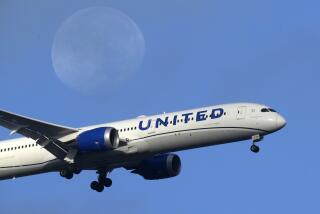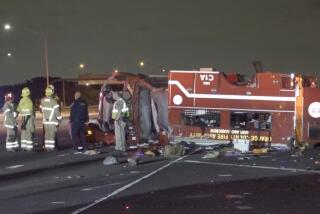First responders to Asiana crash tell of race to rescue passengers
SAN FRANCISCO â Jet fuel was leaking from Asiana Airlines Flight 214 as firefighters boarded the plane in what they described as a race against time to rescue passengers from the wreckage, first responders said Monday.
More than a dozen first responders came to a news conference to describe the chaotic scene in new detail. Many said responding to the plane crash, which killed two and seriously injured scores more, was beyond their normal experience.
San Francisco Fire Department Assistant Chief Tom Siragusa said âthis is something we train for ... but itâs not something many people would see in their career.â
He said there was nothing he would have done differently.
Lt. Christine Emmons said she was at the stationâs âcrash houseâ -- the nickname for one of the airport fire stations. When they responded to the crash, she turned the corner and saw a plume of smoke coming from the plane.
âAdrenaline was flowing at this time,â she said. Emmons kept reminding the driver âif we donât get there, weâre not going to help anybody.â
Emmons said she and other firefighters literally ran up the emergency chutes. Most of the fire was toward the front of the plane. The conditions worsened as they moved to the rear and the smoke and flames grew.
The air was clearest near the back of the plane, where the crash had the âgreatest impact,â according to Emmons.
They found a passenger there, pinned between two seats.
Emmons said they saw jet fuel leaking from the engines. The flames spread overhead as they worked through the plane.
âI feel very lucky and blessed we were able to get those people out at that time,â she said.
The details emerged just a day after officials said the jetliner was flying far below its intended landing speed and on the verge of stalling before the aircraft clipped a sea wall and slammed into the runway.
The targeted landing speed for the Boeing 777-200ER is 137 knots, and the South Korean jetliner was âsignificantlyâ below that, said Deborah A.P. Hersman, chairwoman of the National Transportation Safety Board.
Independent flight tracking data indicate the wide-bodyâs airspeed might have dipped to as low as 85 knots in the moments leading up to the crash.
Hersman said there was a call in the cockpit to increase speed seven seconds before the planeâs tail struck the sea wall that separates the airportâs runway from the bay.
According to onboard flight and voice recorders, the pilots received a warning four seconds before impact that the aircraft was approaching a stall -- a speed so low it can no longer generate enough lift to stay aloft.
At 1.5 seconds before impact, there was a call for the plane to abort the landing and circle around, Hersman said. By then it was too late, as the jetliner crashed and broke apart, killing two passengers and injuring dozens of others. The plane was carrying 307 people.
Asked whether pilot error may have been a factor, Hersman said: âEverything is on table right now. Nothing has been ruled out.â
Wang Linjia and Ye Mengyuan, 16-year-old girls from the eastern Chinese province of Zhejiang, were named over the weekend as the crashâs sole fatalities. Sunday afternoon, officials said one of the two teens may have been run over by an emergency vehicle. More than 180 other people were taken to hospitals after the incident. At least two of those were paralyzed with spinal injuries, and eight remained in critical condition Sunday, hospital officials said.
ALSO:
NTSB official offers new details on S.F plane crash
Dramatic photos from inside Asiana plane after it crashed
Asiana pilot sought second pass at landing moments before crash
More to Read
Sign up for Essential California
The most important California stories and recommendations in your inbox every morning.
You may occasionally receive promotional content from the Los Angeles Times.













